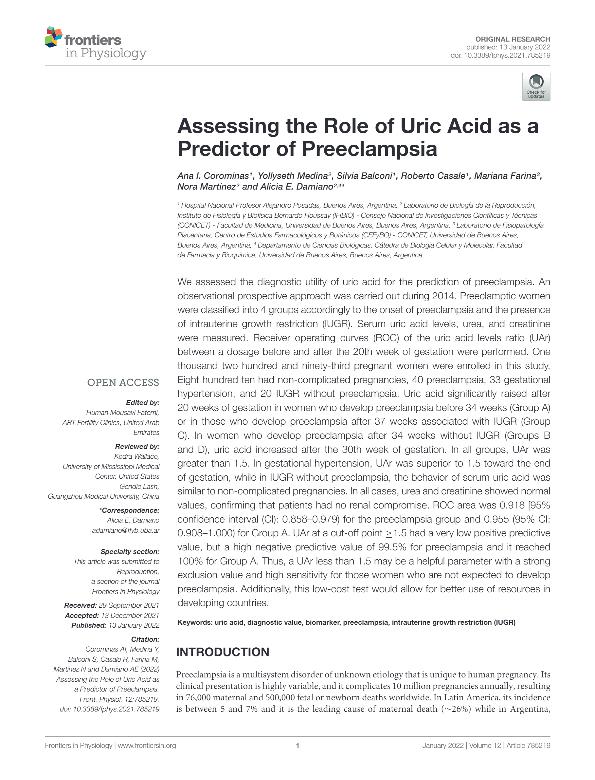Artículo
Assessing the Role of Uric Acid as a Predictor of Preeclampsia
Corominas, Ana Irene; Medina Mora, Yollyseth Astrid ; Balconi, Silvia; Casale, Roberto; Farina, Mariana
; Balconi, Silvia; Casale, Roberto; Farina, Mariana ; Martínez, Nora Alicia; Damiano, Alicia Ermelinda
; Martínez, Nora Alicia; Damiano, Alicia Ermelinda
 ; Balconi, Silvia; Casale, Roberto; Farina, Mariana
; Balconi, Silvia; Casale, Roberto; Farina, Mariana ; Martínez, Nora Alicia; Damiano, Alicia Ermelinda
; Martínez, Nora Alicia; Damiano, Alicia Ermelinda
Fecha de publicación:
13/01/2022
Editorial:
Frontiers Media
Revista:
Frontiers in Physiology
ISSN:
1664-042X
Idioma:
Inglés
Tipo de recurso:
Artículo publicado
Clasificación temática:
Resumen
We assessed the diagnostic utility of uric acid for the prediction of preeclampsia. An observational prospective approach was carried out during 2014. Preeclamptic women were classified into 4 groups accordingly to the onset of preeclampsia and the presence of intrauterine growth restriction (IUGR). Serum uric acid levels, urea, and creatinine were measured. Receiver operating curves (ROC) of the uric acid levels ratio (UAr) between a dosage before and after the 20th week of gestation were performed. One thousand two hundred and ninety-third pregnant women were enrolled in this study. Eight hundred ten had non-complicated pregnancies, 40 preeclampsia, 33 gestational hypertension, and 20 IUGR without preeclampsia. Uric acid significantly raised after 20 weeks of gestation in women who develop preeclampsia before 34 weeks (Group A) or in those who develop preeclampsia after 37 weeks associated with IUGR (Group C). In women who develop preeclampsia after 34 weeks without IUGR (Groups B and D), uric acid increased after the 30th week of gestation. In all groups, UAr was greater than 1.5. In gestational hypertension, UAr was superior to 1.5 toward the end of gestation, while in IUGR without preeclampsia, the behavior of serum uric acid was similar to non-complicated pregnancies. In all cases, urea and creatinine showed normal values, confirming that patients had no renal compromise. ROC area was 0.918 [95% confidence interval (CI): 0.858–0.979) for the preeclampsia group and 0.955 (95% CI: 0.908–1.000) for Group A. UAr at a cut-off point ≥1.5 had a very low positive predictive value, but a high negative predictive value of 99.5% for preeclampsia and it reached 100% for Group A. Thus, a UAr less than 1.5 may be a helpful parameter with a strong exclusion value and high sensitivity for those women who are not expected to develop preeclampsia. Additionally, this low-cost test would allow for better use of resources in developing countries.
Archivos asociados
Licencia
Identificadores
Colecciones
Articulos(CEFYBO)
Articulos de CENTRO DE ESTUDIOS FARMACOLOGICOS Y BOTANICOS
Articulos de CENTRO DE ESTUDIOS FARMACOLOGICOS Y BOTANICOS
Articulos(IFIBIO HOUSSAY)
Articulos de INSTITUTO DE FISIOLOGIA Y BIOFISICA BERNARDO HOUSSAY
Articulos de INSTITUTO DE FISIOLOGIA Y BIOFISICA BERNARDO HOUSSAY
Citación
Corominas, Ana Irene; Medina Mora, Yollyseth Astrid; Balconi, Silvia; Casale, Roberto; Farina, Mariana; et al.; Assessing the Role of Uric Acid as a Predictor of Preeclampsia; Frontiers Media; Frontiers in Physiology; 12; 13-1-2022; 7852-7867
Compartir
Altmétricas



